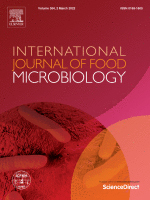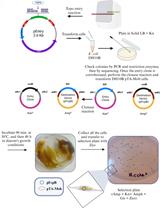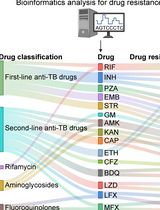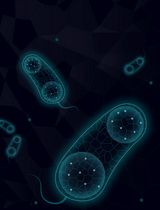- EN - English
- CN - 中文
SIMBA Method—Simultaneous Detection of Antimicrobial and Anti-biofilm Activity of New Compounds Using Salmonella Infantis
SIMBA法——利用婴儿沙门氏菌同时检测新化合物的抗菌和抗生物膜活性
发布: 2023年08月05日第13卷第15期 DOI: 10.21769/BioProtoc.4783 浏览次数: 1938
评审: Shailesh KumarAnonymous reviewer(s)
Abstract
The development of antimicrobial resistance and the formation of Salmonella biofilms are serious public health problems. For this reason, new natural compounds with antimicrobial and anti-biofilm activity are being sought, and wild fungi represent an untapped potential. Various extraction agents, including organic solvents and aqueous buffers, can be used to obtain bioactive compounds from natural sources. To evaluate their bioactivity, extensive screening studies are required to determine antimicrobial and anti-biofilm activity using methods such as broth microdilution or crystal violet assay, respectively, but none of these methods allow simultaneous evaluation of both activities against bacteria. Cold water extraction from wild fungi offers the advantage of extracting water-soluble compounds. The SIMultaneous detection of antiMicrobial and anti-Biofilm Activity (SIMBA) method combines the testing of both types of activity against bacteria with the evaluation of the 20 h growth curve of the Salmonella Infantis ŽM9 strain determined with absorbance measurements at 600 nm in a 96-well plate. SIMBA method thus shortens the time to determine the bioactivity of extracts, reduces material consumption, and eliminates the need for additional reagents. SIMBA enables rapid selection of bioactive extracts for their fractionation and shortens the time to determine new natural products with antimicrobial and anti-biofilm activity.
Graphical overview

Background
Biofilm formation is a persistence strategy for bacteria that plays a role both for biotic surfaces causing chronic infections and for colonization and survival on abiotic surfaces. After attachment to different surfaces, Salmonella spp. can form a protective matrix of extracellular polymeric substances (EPS) that protects bacteria from environmental factors, facilitates gene transfer, and increases nutrient availability and bacterial resistance to antimicrobial agents. Therefore, Salmonella biofilm cells exhibit higher environment survival and increased antimicrobial resistance, both of which are associated with more human infections (Steenackers et al., 2012; MacKenzie et al., 2017; González et al., 2018; Tassinari et al., 2019). In addition, antimicrobial resistant Salmonella are widespread in animals and on various surfaces associated with animal production and food processing (Vestby et al., 2009; Pate et al., 2019; Tassinari et al., 2019). Alternative control strategies for these Salmonella are being sought due to their resistance to environmental stress and to commercial antibacterial agents.
Higher fungi represent an underexplored source of antimicrobial compounds; fruiting bodies of cultivated and wild mushrooms have been shown to contain various antimicrobial compounds, ranging from secondary metabolites such as steroids, terpenes, and quinolines, to peptides and proteins (Alves et al., 2012; Erjavec et al., 2012). Different solvents have been used for the extraction of new potential antimicrobial compounds. Organic solvents such as methanol, ethanol, ethyl acetate, chloroform, acetone, ether, xylene, cyclohexane, or dichloromethane are the most commonly used, while aqueous extraction with hot water or cold aqueous buffers is rarely used (Alves et al., 2012; Klančnik et al., 2017; Gómez Román et al., 2020). The advantage of using water for extraction is that water-soluble compounds can be extracted, which is beneficial for their potential use as antimicrobials. Water solubility is a very important parameter for drug formulations, as poorly soluble drugs are associated with poor absorption and low bioavailability and often require higher doses (Savjani et al., 2012).
Antimicrobials inhibit bacterial growth or kill bacteria, while specific anti-biofilm agents can interact with biofilm-related metabolic processes without affecting bacterial growth (Steenackers et al., 2012). These two concepts must be considered separately, as compounds that interfere with growth may also contribute to faster development of bacterial resistance. Because of their importance in bacterial persistence, there is a need to control biofilms and their formation without affecting bacterial growth (Dieltjens et al., 2020). Currently, different methods are used to test antimicrobial activity and anti-biofilm activity. Methods performed in microtiter plates are based on similar principles, and determination of minimum inhibitory concentration in the form of broth microdilution is used to evaluate antimicrobial activity. Determination of anti-biofilm activity requires more manipulation because the biofilm is formed on the surface, and therefore steps to wash and detach the cells are required, followed by determination of the culturable cells by dilution and plating. In addition, various indicators can be used as colorimetric indicators of microbial metabolic activity of microorganisms to evaluate viability in antimicrobial activity analysis, for example, tetrazolium salts such as 2,3,5-triphenyltetrazolium chloride (TTC), 3-(4,5-dimethylthiazol-2-yl)-2,5-diphenlytetrazolium bromide (MTT), or 2-(4-iodophenil)-3-(4-dinitrophenyl)-5-phenyltetrazolium chloride (INT). Resazurin can also be used to determine the viability of microorganisms, measured as a fluorescence signal or with some commercially available kits such as PrestoBlueTM. The bioluminescence signal can also be used to determine the ATP activity of microorganisms using commercially available kits such as BacTiter-GloTM. Similarly, dye assays can also be used to assess anti-biofilm activity, such as crystal violet, safranin, or acridine orange (Klančnik et al., 2010 and 2021; Eloff, 2019).
All of these methods require manipulation after initial incubation; some use reagents that are hazardous to the environment, and two methods must be performed to evaluate both activities. Here, we present a method for SIMultaneous detection of antiMicrobial and anti-Biofilm Activity (SIMBA) published in Sterniša et al. (2022a). It is a 96-well microplate-based method that, compared to other antimicrobial and anti-biofilm assays, does not require additional plate manipulations after plate preparation, does not require reagents, and provides results within 20 h. We additionally provide the workflow to predict antibacterial or anti-biofilm activity using freely available software Orange (Demšar et al., 2013). A learner on predicting the activity of new compounds is trained on a provided dataset consisting of experimentally verified data and then a workflow is provided to predict the activity of the unknown compound. This presents a step forward to analyzing growth curves by advanced algorithms further supporting high-throughput methods like SIMBA. Namely, SIMBA was shown to reduce costs by up to 50% and time to completion in the laboratory by up to 80%. Interpretation of results is based on a computer program, making it objective and straightforward. This protocol can be used for screening extracts for novel antimicrobial and/or anti-biofilm compounds, as well as for bioactivity-guided purification of such compounds. Other areas where this protocol can be useful for faster analysis of antimicrobial and anti-biofilm activities include testing of commercial products such as food or feed additives, pesticides, biocides, or disinfectants and wastewater analysis.
Materials and reagents
Ice
600 mL glass beaker (Brand, catalog number: BR90648)
Disposable viscose cloths (Tosama, catalog number: 23073)
Large potato ricer
HiPrep 26/60 Sephacryl® S-200 HR column (Cytiva, catalog number: 17-1195-01)
Liquid chromatography column 3 × 100 cm (custom made)
0.2 μm syringe filters (Minisart NML, Sartorius, catalog number: 16534)
10 mL syringe (BD Emerald, catalog number: 307736)
50 mL centrifuge tube (Sarstedt, catalog number: 62.547.004)
Transparent flat-bottomed 96-well microplates (Thermo Scientific Nunc, catalog number: 266120)
15 mL centrifuge tube (Sarstedt, catalog number: 62.554.502)
1.5 mL microcentrifuge tubes (Eppendorf, catalog number: 0030 120.086)
1–10 mL tips (Eppendorf, catalog number: 0030 000.765)
50–1,000 μL tips (Eppendorf, catalog number: 0030 000.927)
2–200 μL tips (Eppendorf, catalog number: 0030 000.870)
Cuvettes (Brand, catalog number: 7590 15)
Tryptic soy broth (TSB) (Biolife, catalog number: 4021552)
Tryptic soy agar (TSA) (Biolife, catalog number: 4021502)
Phosphate buffered saline (PBS) (Oxoid, catalog number: BR0014G)
Na2HPO4 (Sigma-Aldrich, catalog number: S9763)
NaCl (Sigma-Aldrich, catalog number: S9888)
KH2PO4 (Sigma-Aldrich, catalog number: P0662)
KCl (Sigma-Aldrich, catalog number: P3911)
NaOH (Sigma-Aldrich, catalog number: S5881)
HCl (Sigma-Aldrich, catalog number: 258148)
Tris (Serva, catalog number: 37180)
Salmonella enterica subsp. enterica Infantis ŽM9 (culture collection of the Laboratory for Food Microbiology at the Department of Food Science, Biotechnical Faculty; GenBank accession number JARDYW000000000)
20× PBS (concentrated phosphate buffered saline) (see Recipes)
30 mM Tris-HCl, pH 7.5 with 0.4 M NaCl (see Recipes)
2× TSB (see Recipes)
Equipment
Refrigerated centrifuge (Thermo Fisher Scientific, Sorwall Lynx 4000)
ÄKTA pure protein purification system (Cytiva 29018224)
Microplate reader (Thermo Fisher Scientific, Varioskan Lux)
Incubator (Kambič, I-105CK)
Vortex (Domel, Vibromix 10)
Pipette set (Eppendorf, catalog number: 3120 000.836)
1–10 mL pipette (Eppendorf, catalog number: 3123 000.080)
10–100 μL multichannel pipette (Eppendorf, catalog number: 3125 000.044)
Biosafety cabinet (Iskra Pio, SMBC 122AV)
Ultra-low temperature freezer (Haier, DW-86L728ST)
Freezer (LTH, HG 5.1Z)
Spectrophotometer (Perkin Elmer, Lambda Bio+)
Microplate mixer (Eppendorf, ThermoMixer C)
Software
SkanIt RE 5.0 Plate Reader Software (Thermo Fisher Scientific, https://www.thermofisher.com/si/en/home/life-science/lab-equipment/microplate-instruments/plate-readers/software.html)
Excel (Microsoft Corporation, https://office.microsoft.com/excel)
R: A language and environment for statistical computing (R Core Team, http://www.R-project.org/)
Growthcurver: simple metrics to summarize growth curves (Sprouffske and Wagner, 2016, https://github.com/sprouffske/growthcurver, https://cran.r-project.org/web/packages/growthcurver/vignettes/Growthcurver-vignette.html)
Orange Data Mining (Demšar et al., 2013, University of Ljubljana, Faculty of Computer and Information Science, https://orange.biolab.si)
Procedure
文章信息
版权信息
© 2023 The Author(s); This is an open access article under the CC BY-NC license (https://creativecommons.org/licenses/by-nc/4.0/).
如何引用
Sterniša, M., Sabotič, J., Janež, N., Curk, T. and Klančnik, A. (2023). SIMBA Method—Simultaneous Detection of Antimicrobial and Anti-biofilm Activity of New Compounds Using Salmonella Infantis. Bio-protocol 13(15): e4783. DOI: 10.21769/BioProtoc.4783.
分类
微生物学 > 抗微生物试验 > 抗细菌试验
微生物学 > 微生物生物膜
生物科学 > 微生物学
您对这篇实验方法有问题吗?
在此处发布您的问题,我们将邀请本文作者来回答。同时,我们会将您的问题发布到Bio-protocol Exchange,以便寻求社区成员的帮助。
Share
Bluesky
X
Copy link













